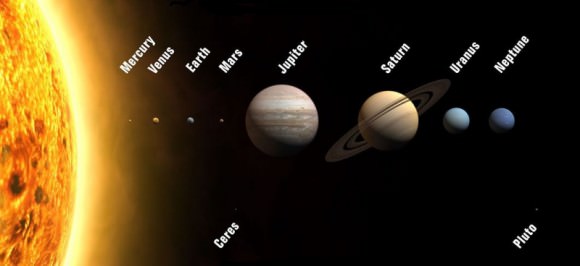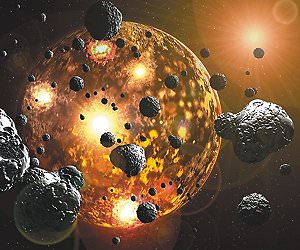[/caption]
Mars is a small planet. In fact, for scientists who do solar system modeling, the planet is too small. “This is an outstanding problem in terrestrial planet formation,” said Dr. David Minton from the Southwest Research Institute. “Everyone who does simulations of how you form terrestrial planets always ends up with a Mars that is 5-10 times bigger than it is in real life.” Minton has been working alongside colleague Dr. Hal Levison to create new simulations that explain the small size of Mars by including the effect of what is known as planetesimal-driven migration, and additionally, small objects that Minton calls “Marstinis” could stir or shake up our ideas about the early solar system and the Late Heavy Bombardment.
Planetary scientists agree that the terrestrial planets formed very quickly within the first 50-100 million years of the solar system’s history and our Moon formed from an impact between a Mars-sized object and the proto-Earth at some point during that time. Much later was the Late Heavy Bombardment, the time period where a large number of impact craters formed on the Moon within a time span of only seventy million years — and by inference Earth, Mercury, Venus, and Mars were likely pummeled as well.
Most planetary formation theories can’t account for this intense period of bombardment so late in the solar system’s history, but Levison was part of a team that in 2005 proposed the Nice Model, which suggested how the Late Heavy Bombardment was triggered when the giant planets — which formed in a more compact configuration – rapidly migrated away from each other (and their orbital separations all increased), and a disk of small “planetesimals” that lay outside the orbits of the planets was destabilized, causing a sudden massive delivery of these planetesimals – asteroids and comets — to the inner solar system.
But, according to the model, planetesimals likely also caused the migration of the planets, too. The planets formed from a giant disk of gas, dust, rocky debris and ice surrounding the early Sun. Debris coalesced to form bigger planet-sized objects, and simulations shows that bigger planet-sized object embedded in a disk of smaller objects will migrate as a result of angular momentum and energy conservation as the planets scatter the planetesimals they encounter.

“Perturbations from small rocky or icy objects surrounding a larger object can cause the larger object to ‘scoot’ along the disk,” Minton told Universe Today. “Every time these little planetesimals encounter the bigger object, they actually cause a little nudge in the position of the bigger object. It turns out if you work out the math, if there is any sort of slight imbalance to the number of objects encountering on the sunward side versus encountering on the anti-sunward side, you can actually cause a net movement of the big body, and it actually happens pretty quickly.”
Minton and Levison have been applying the same physics of planetesimal-driven migration to the formation of the terrestrial planets.
“In the case of Mars, imagine these planetary embryos located in the Earth-Venus zone,” Minton said. “Then you have a one little embryo growing to become Mars-sized, and it would start migrating because of planetesimal-driven migration, and it scoots away from the other guys. So it has left the pack, and as it moves through the disk, it gets stranded away from where all the action is going on.”
So Mars’ growth got stalled at its current size because it migrated away from the planet-building materials.
Minton said their simulations of this work really well.
“We’ve been doing a lot of math and the migration is pretty rapid,” he said, “and Mars could migrate through the disk before any other Mars-sized planet could form. In an early solar system where you have a Mars stranded off at the edge of the disk at 1.5 AU, which is where it is right now and all the other action going on in the Earth-Venus zone, then Earth and Venus were able to grow to the size they are now, where they are both roughly the same size and mass and Mars is stranded on its own.”
And with Mars there is a twist of Marstinis, which could offer an alternate explanation for the Late Heavy Bombardment.
The migrating Mars could have picked up planetesimals in its resonance, where two or more orbiting bodies exert a gravitational influence on each other.
“It is not at all obvious why that is,” Minton said, “but the same thing is thought to have happened in the outer solar system which is what gave Pluto its orbit. We think Pluto was actually picked up in the 3:2 resonance with Neptune when Neptune migrated out, and that’s why Pluto and the other “Plutinos” are living in these resonances with Neptune.”
The Plutinos are other Kuiper Belt objects near Pluto. That resonance means Pluto and the Plutinos go around the Sun three times for every 2 times Neptune does. There are also Two-tinos, which are caught in a 1:2 resonance with Neptune – and which are found towards the outer edge of the Kuiper belt. The new simulations show that these lines of resonances are almost like a snowplow, and as Neptune migrated out it picked up all these little icy bodies, Pluto and the Plutinos.

This also could have happened to Mars, and as Mars migrated through the disk it would have also picked up little objects.
“I’ve decided to calls these Marstinis, to keep in the Plutino and Two-tino, theme,” Minton said with a grin. “I don’t know if that will stick or not.”
But the interesting thing about the Marstinis, Minton said, is that a 3:2 resonance with Mars is actually a very unstable zone.
“There is actually a resonance there with Saturn that only existed in the time of the Late Heavy Bombardment,” he said, “so before that, Saturn — we think — was in a different position, so this particular resonance was in a different position. So it was only after the giant planets migrated to their current location that this resonance location became unstable. So we think that these Marstinis would have been stable and in that interim period between the end of planet formation and the Late Heavy Bombardment, all of a sudden this region became unstable when the planets shifted positions to their current locations.”
So could the Marstinis be responsible for the Late Heavy Bombardment?
“These Marstinis were pushed out from the planet forming regions out to the asteroid belt,” Minton said, “then all of a sudden the planets migrated and this whole region became unstable and so they all could have gone flinging into the inner solar system and end up hitting the Moon.”

There are a couple of other arguments, too where the Marstinis fit the profile of what hit the Moon during the Late Heavy Bombardment.
“We have reasons to think that the objects that hit the Moon during the Late Heavy Bombardment were sort of like asteroids but not exactly like the asteroids we have now,” Minton said. “So, there are some chemical arguments you can make, also you can make some arguments from the impact probabilities that may not have been enough mass in the asteroid belt to supply all the asteroids and impacts we see on the Moon.”
But there are other outstanding issues such as how long the Late Heavy Bombardment lasted, when it started, were comets ever important in the bombardment history of the Moon or was it all asteroids? Minton said further exploration of the Moon would answer many of these questions.
“These are all things that we really need to go to the Moon to find out and there is almost nowhere else you can go to do it. It really is one of the best places to go to understand all the solar system history.
Minton will present his findings at the upcoming Lunar and Planetary Science Conference in March, 2011.
You can listen to an interview I did with Minton about planetesimal-driven migration for the NASA Lunar Science Institute podcast (also available on the 365 Days of Astronomy.)


“That resonance means Pluto and the Plutinos go around the Sun three times for every 2 times Neptune does.”
Shouldn’t that be reversed?
It seems like another possibility is that Mars is just a very large former member of the main asteroid belt. There is plenty of evidence that other main belt asteroids have migrated inward. Why not Mars?
“Everyone who does simulations of how you form terrestrial planets always ends up with a Mars that is 5-10 times bigger than it is in real life.”
That is an overstatement IIRC, there have been Nice mods that makes a Mars (but I don’¨t think I cared enough to have the refs, just like I won’t google it now).
Just not very reliably (i.e. likely) I believe, which the new scenario may achieve FWIW.
A nice theory.
Planetary motion studies over deep time must by definition include the unpredictable due to the possibility of outside influences, including passing stars, gravity waves or other unknown or predicted energetic events. So you are right, being a ‘nice theory’ is all about where science and guesstimation cross swords?
Gravity waves that rattle the width of a proton an “energetic event”? Sure, and Santa Claus is for real.
If influences are frequent, they can be accounted for. It’s the rare events that are a problem, but by definition they are… um, rare.
Could Phobos / Demios be some of these planetesimals that were dragged along with Mars when it migrated?
It could be, but the main hypotheses right now is that they are remains from one Moon-sized planetesimal hitting Mars (explaining Mars dichotomy, various features of Phobos and Deimos, and Mars craters that looks like deorbited moons of the Phobos/Deimos kind).